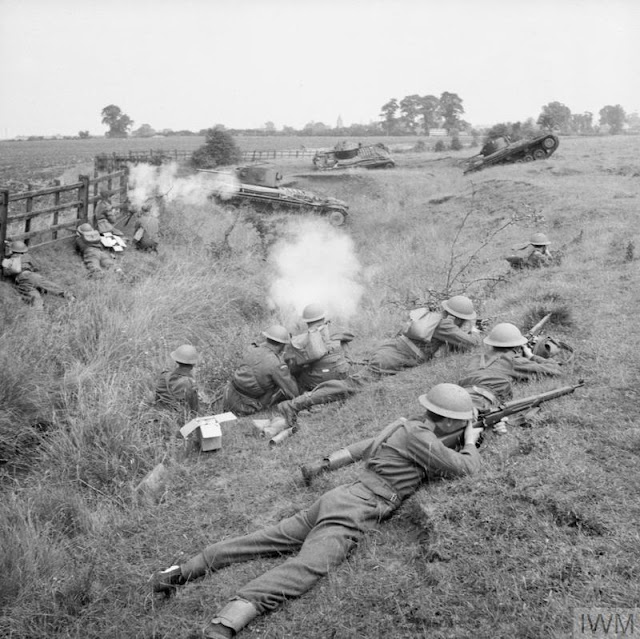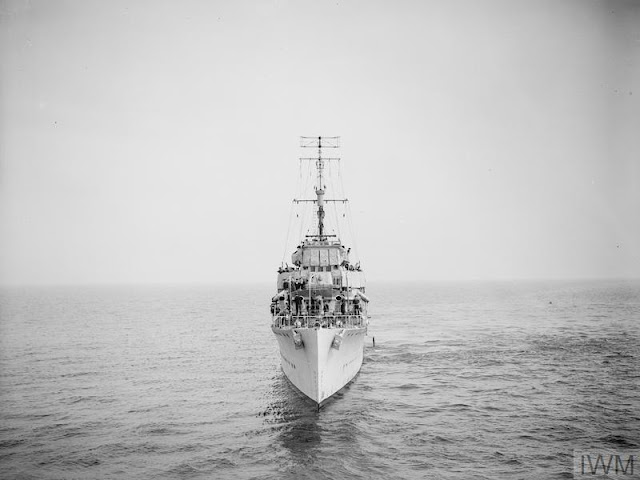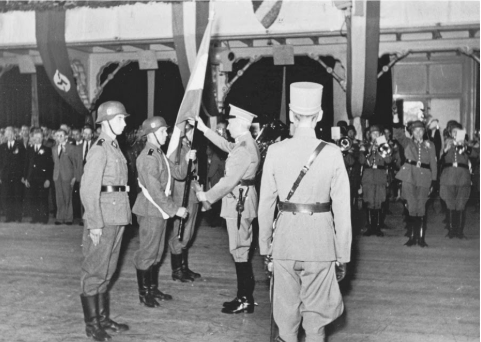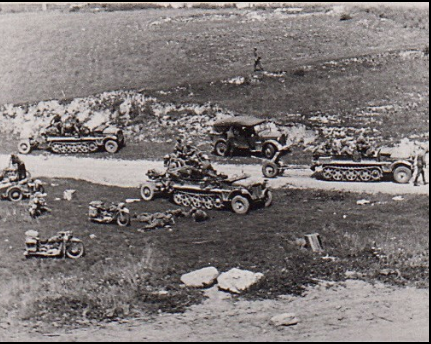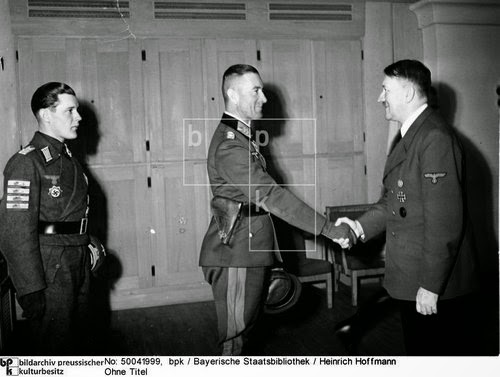Monday 28 July 1941
 |
| "'Rip' the dog and an ARP Warden survey the scene of devastation following an air raid in Latham Street, Poplar. The bomb crater is full of water. In the background, the remains of the local surface shelter can be seen, which, although slightly damaged, is still largely intact. Piles of rubble and timber can also be seen." 28 July 1941. © IWM (D 5950). |
Eastern Front: The German forces make only minimal advances today because Hitler has ordered the consolidation of the massive gains already made. While not welcomed by the commanders at the front, this pause provides a chance for the mechanics to work on vehicles and the infantry to catch up to the leading panzers.
In the Army Group North sector, advance Wehrmacht units of Panzer Group 4 take Kingisepp, 138 kilometers (86 miles) southwest of Leningrad and 40 km (25 miles) south of the Gulf of Finland. The Soviets are preparing to make a stand on the Luga River.
In the Army Group Center sector, the Germans have closed a large pocket around Soviet troops in the vicinity of Smolensk and now are attempting to subdue it. A large group of trapped Soviet forces, led by the 20th Army, prepares to attempt a breakout.
In the Army Group South sector, the Stavka orders Marshal Budenny (Budyonny), in command of 1.5 million men of Southern and Southwestern Fronts, to focus on preventing the Germans from establishing any bridgeheads across the Dneiper. In effect, the Stavka tries to freeze the front and further orders that retreats are only permissible in an easterly direction. The Soviet troops still have an open road to retreat to the southeast, but now they cannot do that.
The Germans, meanwhile, continue compressing the huge concentration of Soviet troops in the Uman area into a smaller and smaller area. The two Soviet Fronts have their headquarters in the town of Podvisokoye (Подвысокое). The Germans continue struggling to close the pocket, with Panzer Group 1 (von Kleist) pushing toward advance units of 17th Field Army (Karl-Heinrich von Stulpnagel) and 16th Panzer Division heading toward the Hungarian Mechanized Corps.
Hauptmann (Captain) Walter Oesau leaves III./JG 3 to take the position of Kommodore of JG 2. Hptm. Werner Andres replaces Oesau as Gruppenkommandeur of III Gruppe JG 3. Lt. Max-Hellmuth Ostermann of 7./JG 54 downs a Russian I-18.
European Air Operations: Weather continues to be poor over northwest Europe. The cloudy conditions make it difficult for bombers to find a particular city, let alone targets of value within them. There is a minelaying operation by 42 RAF bombers during the night in the Baltic.
Battle of the Baltic: Soviet submarine ShCh-307 torpedoes and sinks U-144 (Gert von Mittelstaedt) in the Gulf of Finland north of Hiiumaa. All 28 men onboard perish. Most sources place this sinking on 10 August 1941, and that is the generally accepted date for the sinking, but either date is possible. U-144 is in 22. Flotilla and sank one Soviet submarine, M-78, of 206 tons on 23 June 1941.
The Red Air Force bombs and sinks 315-ton German freighter Elbing III near Liepāja, Latvia.
The Red Air Force bombs and sinks German minesweeper R-169 near Libau.
German 3rd S-boat Flotilla is operating off Osel when it sinks 253-ton Latvian icebreaker Lashplesis near Saaremaa (Oesel/Ösel), Estonia.
German patrol boat V.309/Martin Donandt hits a mine and sinks off Libau. The mine was laid by Soviet minesweeper T-204/Fugas.
Battle of the Atlantic: A U-boat wolf pack continues to stalk Convoy OG-69 northwest of Cape Finisterre. Attacks continue throughout the day, and it is a confusing affair, with different U-boat captains claiming the same kills.
U-68 (K.Kapt. Karl-Freidrich Merten) starts things off with Convoy OG-69 in the early morning hours when Merten claims to make an attack. However, the attack fails and U-68 has no success with the convoy now or later.
U-561 (Kptlt. Robert Bartels), on its first patrol out of Hamburg, later in the pre-dawn hours then gets its first-ever victory by torpedoing and sinking 1884-ton British freighter Wrotham in Convoy OG-69. All 26 crew survive. Bartels, like Mertens, claims to make additional attacks, but there is no record of them succeeding.
After dark at 21:27, U-203 (Kptlt. Rolf Mützelburg), on its second patrol out of Lorient, torpedoes and sinks two ships of Convoy OG-69 in quick succession (with the same spread of torpedoes):
The Luftwaffe bombs 212-ton British fishing trawler Strathlochy about 180 miles northwest of Rora Head, Orkneys.
Royal Navy corvette HMS Tamarisk is launched and destroyer Wensleydale and minesweeping trawler Foula are laid down.
Norwegian 4785-ton freighter Highlander, which escaped from internment at Dakar and was being chased by Vichy French patrol boat Edith Germaine, is taken under protection by Royal Navy destroyer HMS Highlander. They proceed to Freetown along with destroyer Boreas.
The ships of Operation EF, the projected raid on Kirkenes and Petsamo, continue steaming toward their destination in northern Norway. The operation's destroyers refuel from fleet oiler Black Ranger near the Russian Kola coast.
Convoy HG-69 departs from Gibraltar bound for Liverpool.
US Navy destroyer USS Corry is launched.
U-625 and U-626 are laid down.
Battle of the Mediterranean: Royal Navy submarine HMS Utmost torpedoes and sinks 1466-ton Italian freighter Federico C. off Intavolata, western Calabria.
Dutch submarine O-21 torpedoes and sinks 747-ton Italian freighter Monteponi ten miles north of Cape Comino, Sardinia. This becomes a favored scuba-diving site
Royal Navy submarine HMS Upholder spots an Axis convoy heading from Tripoli to Naples off Cape St. Vito. It torpedoes and sinks Italian light cruiser Garibaldi. The cruiser makes it to Palermo, Sicily at daybreak on the 29th and is under repair until November 1941.
The Luftwaffe bombs and sinks Royal Navy lighter A-8 off Bardia. There are 8 deaths. Another lighter, A-14, is nearby but escapes.
The Regia Aeronautica bombs and damages Royal Navy submarine HMS Olympus off Cavoli Light in the Tyrrhenian Sea. The submarine manages to make it back to Gibraltar.
The RAF launches raids from Malta on Sicily that destroy 36 Axis aircraft. The commanding officer of the Regia Aeronautica, General Federigi, perishes in aerial combat over Malta.
The Luftwaffe attacks the Suez Canal during the night.
The nightly run to Tobruk is made by destroyers HMS Hotspur and HMAS Vendetta. Early on the 29th, the ships take off some Australian troops - many of whom are exhausted from spending months isolated in the port with inadequate supplies and Axis shelling - and take them to Mersa Matruh.
Operation Guillotine, the Royal Navy reinforcement of Cyprus, continues as corvette HMS Hyacinth escorts transport Kevinbank to Famagusta.
An RAF night fighter unit begins operation at Malta. It is led by Group Captain George Powell-Shedden and based at Ta Qali.
Special Operations: Operation Chess, which began on 27 July, concludes. Second Lieutenant Philip Pinckney leads 17 men of No. 12 Commando to a landing from two landing craft. Much about this operation is obscure. Even the landing area is uncertain. According to some sources it occurs about two miles from the River Slack near Ambleteuse, Pas-de-Calais, France, while other sources claim it is further south at Fécamp. The landing force arrives at about 01:30 and occupies empty ground for an hour or two, then departs the way it arrived. There are one or two deaths from unknown causes - sources vary - but, apparently, they are not due to enemy action. Cdr. Sir Geoffrey Congreve Bt DSO, the Commando's Senior Landing Officer, is said to have perished during this raid, and perhaps a Lt. J. Templeton RNR and an unidentified rating, but details on the rather uneventful Operation Chess are hard to come by.
Anglo/Finnish Relations: Finnish Foreign Minister Witting meets with British Ambassador Sir Gordon Vereker and rather sheepishly informs him that Finland has to 'interrupt' her diplomatic relations with the United Kingdom. Relations with the United States, however, remain fully intact.
Dutch/Japanese Relations: The authorities in the Dutch East Indies ban all oil exports, an obvious slap at the Japanese. This piles on to US sanctions recently imposed.
US/Japanese Relations: The Japanese retaliate for the freezing of Japanese assets in the United States by doing the same to US assets in Japan. This is more of a symbolic move than anything else, as there aren't many US assets in Japan.
Imperial Japanese Navy oiler Otowasan arrives at San Pedro, California to take on a load of oil. However, due to the embargo placed on oil exports to Japan begun on the 26th, it is refused service and must return to Japan only with ballast.
German/Vichy French Relations: The Petain government agrees to manufacture Luftwaffe aircraft in France.
Anglo/Soviet Relations: Soviet Premier Joseph Stalin receives a message from British Prime Minister Winston Churchill. This continues a pattern in their correspondence in which Churchill sends a stream of messages and Stalin rarely responds (he is said to be "too busy running the war," but this does not seem to hinder Churchill). Churchill comments that President Roosevelt's crony, Harry Hopkins, has left to visit the Soviet Union (by air, though that is not mentioned) and "You will be advised of his arrival through the proper channels." Hopkins is heading for Archangel. As usual, Stalin does not respond.
Soviet Military: The Stavka issues Stavka Directive No. 00549, "Concerning Measures to Regulate the Employment of Artillery in the Defense." The general thrust of this directive is to employ massed artillery to weaken sections of the German line prior to counterattacks. While this is eminently reasonable and a staple of tactical doctrine, it is symptomatic of the state of the Red Army that the leadership thinks it necessary to issue such basic instruction.
US Military: The 1st Joint Training Force is formed, with commander Major General Holland M. Smith. This is just a redesignation of the joint US Army and US Marine Corps unit Task Force 18, attached to the US Atlantic Fleet.
German Government: Hitler recently has been clarifying in his own mind the ultimate objectives for Operation Barbarossa (incredibly, he seems not to have done this in any sort of detail before the invasion). According to the diary of his army adjutant, Major Gerhard Engel, today he somewhat randomly comments after the noon situation conference that he considers the southern lands of the USSR more important than Moscow or Leningrad. Engel writes that the Fuhrer reasoned:
French Indochina: The Japanese 25th Army begins landing its first of 30-40,000 troops at Saigon, Cam Ranh Bay and other strategic points in southern French Indochina. There are to be naval and air bases designed to project Japanese to the south - where the Japanese military covets sources of oil. The Japanese now have airfields within 300 miles of northern Malaya and naval bases within 750 miles of the British port of Singapore. Some Japanese army troops also arrive in Cambodia, the first of 8000 troops the Japanese will place there.
Burma (Myanmar): The first advance party of General Clare Chennault's American Volunteer Group (AVG, or Flying Tigers) arrive by ship at Rangoon.
China: The Japanese Imperial Air Force attacks Sichuan Province with 108 aircraft. The Chinese put up only seven fighters in opposition, and lose three planes. Chinese Lieutenant Gao Chunchou (I-153 no. P-7237) is shot down.
Holocaust: A "Euthanasia Program" begins at Auschwitz Concentration Camp when a select team of SS men arrives on Heinrich Himmler's orders. The first group of 573 sick Polish prisoners is taken from Block 15, along with two German criminals, to Sonnenstein Castle. There, under the supervision of Franz Hössler, the 575 men are exterminated in a shower room converted into a gas chamber. This apparently is the first use of such shower rooms, which quickly become stained blue due to the residue from the gas used.
At Drogobych, Ukraine, locals riot and kill an unknown number of Jews with their bare hands and whatever weapons are handy. Bodies of the dead and dying are thrown in the street.
American Homefront: Judy Garland marries songwriter David Rose. Rose, a native of London, England, leads an orchestra and has his own twice-weekly show on the Mutual Broadcasting System. It is a troubled marriage without issue (and rumors that Rose and Garland's studio, MGM, pressured her into an abortion). They will divorce in 1944.
Future History: Peter Claver Cullen is born in Montreal, Canada. He becomes a noted voice actor, perhaps best known for his role of Optimus Prime in the original 1980s "Transformers" animated series, Eeyore in the "Winnie the Pooh" canon, and the voice of the title character in King Kong (1976). As of this writing in 2018, Peter Cullen remains active, particularly voicing Optimus Prime in new projects.
July 1941
July 1, 1941: US TV Broadcasting Starts
July 2, 1941: MAUD Report
July 3, 1941: Stalin Speaks
July 4, 1941: Pogroms in Eastern Europe
July 5, 1941: Germans on Schedule
July 6, 1941: Australians Attack Damour
July 7, 1941: US Marines in Iceland
July 8, 1941: Flying Fortresses In Action
July 9, 1941: British Take Damour
July 10, 1941: Sword and Scabbard Order
July 11, 1941: Cease-fire in Syria and Lebanon
July 12, 1941: Anglo/Russian Assistance Pact
July 13, 1941: Uprising in Montenegro
July 14, 1941: Katyusha Rocket Launchers in Action
July 15, 1941: Smolensk Falls
July 16, 1941: Stalin's Son Captured
July 17, 1941: Heydrich Orders Mass Executions
July 18, 1941: Twin Pimples Raid
July 19, 1941: V for Victory
July 20, 1941: The Man Who Wouldn't Shoot
July 21, 1941: Moscow in Flames
July 22, 1941: Soviet Generals Executed
July 23, 1941: Secret Plan JB 355
July 24, 1941: Operation Sunrise
July 25, 1941: US Naval Alert
July 26, 1941: Italian E-Boat Attack on Malta
July 27, 1941: MacArthur Returns
July 28, 1941: Auschwitz Exterminations
July 29, 1941: Rescue From Crete
July 30, 1941: Raid on Petsamo and Kirkenes
July 31, 1941: Final Solution Order
2020
In the Army Group North sector, advance Wehrmacht units of Panzer Group 4 take Kingisepp, 138 kilometers (86 miles) southwest of Leningrad and 40 km (25 miles) south of the Gulf of Finland. The Soviets are preparing to make a stand on the Luga River.
In the Army Group Center sector, the Germans have closed a large pocket around Soviet troops in the vicinity of Smolensk and now are attempting to subdue it. A large group of trapped Soviet forces, led by the 20th Army, prepares to attempt a breakout.
In the Army Group South sector, the Stavka orders Marshal Budenny (Budyonny), in command of 1.5 million men of Southern and Southwestern Fronts, to focus on preventing the Germans from establishing any bridgeheads across the Dneiper. In effect, the Stavka tries to freeze the front and further orders that retreats are only permissible in an easterly direction. The Soviet troops still have an open road to retreat to the southeast, but now they cannot do that.
The Germans, meanwhile, continue compressing the huge concentration of Soviet troops in the Uman area into a smaller and smaller area. The two Soviet Fronts have their headquarters in the town of Podvisokoye (Подвысокое). The Germans continue struggling to close the pocket, with Panzer Group 1 (von Kleist) pushing toward advance units of 17th Field Army (Karl-Heinrich von Stulpnagel) and 16th Panzer Division heading toward the Hungarian Mechanized Corps.
Hauptmann (Captain) Walter Oesau leaves III./JG 3 to take the position of Kommodore of JG 2. Hptm. Werner Andres replaces Oesau as Gruppenkommandeur of III Gruppe JG 3. Lt. Max-Hellmuth Ostermann of 7./JG 54 downs a Russian I-18.
 |
| Finnish soldiers, 28 July 1941 (SA-Kuva). |
Battle of the Baltic: Soviet submarine ShCh-307 torpedoes and sinks U-144 (Gert von Mittelstaedt) in the Gulf of Finland north of Hiiumaa. All 28 men onboard perish. Most sources place this sinking on 10 August 1941, and that is the generally accepted date for the sinking, but either date is possible. U-144 is in 22. Flotilla and sank one Soviet submarine, M-78, of 206 tons on 23 June 1941.
The Red Air Force bombs and sinks 315-ton German freighter Elbing III near Liepāja, Latvia.
The Red Air Force bombs and sinks German minesweeper R-169 near Libau.
German 3rd S-boat Flotilla is operating off Osel when it sinks 253-ton Latvian icebreaker Lashplesis near Saaremaa (Oesel/Ösel), Estonia.
German patrol boat V.309/Martin Donandt hits a mine and sinks off Libau. The mine was laid by Soviet minesweeper T-204/Fugas.
 |
| A British motorcycle dispatch rider hands off a message to an occupant of a 1/2 ton, 4x4 Dodge Command Reconnaissance Car, 28 July 1941. |
U-68 (K.Kapt. Karl-Freidrich Merten) starts things off with Convoy OG-69 in the early morning hours when Merten claims to make an attack. However, the attack fails and U-68 has no success with the convoy now or later.
U-561 (Kptlt. Robert Bartels), on its first patrol out of Hamburg, later in the pre-dawn hours then gets its first-ever victory by torpedoing and sinking 1884-ton British freighter Wrotham in Convoy OG-69. All 26 crew survive. Bartels, like Mertens, claims to make additional attacks, but there is no record of them succeeding.
After dark at 21:27, U-203 (Kptlt. Rolf Mützelburg), on its second patrol out of Lorient, torpedoes and sinks two ships of Convoy OG-69 in quick succession (with the same spread of torpedoes):
- 1330-ton British freighter Lapland
- 1516-ton Swedish freighter Norita
The Luftwaffe bombs 212-ton British fishing trawler Strathlochy about 180 miles northwest of Rora Head, Orkneys.
Royal Navy corvette HMS Tamarisk is launched and destroyer Wensleydale and minesweeping trawler Foula are laid down.
Norwegian 4785-ton freighter Highlander, which escaped from internment at Dakar and was being chased by Vichy French patrol boat Edith Germaine, is taken under protection by Royal Navy destroyer HMS Highlander. They proceed to Freetown along with destroyer Boreas.
The ships of Operation EF, the projected raid on Kirkenes and Petsamo, continue steaming toward their destination in northern Norway. The operation's destroyers refuel from fleet oiler Black Ranger near the Russian Kola coast.
Convoy HG-69 departs from Gibraltar bound for Liverpool.
US Navy destroyer USS Corry is launched.
U-625 and U-626 are laid down.
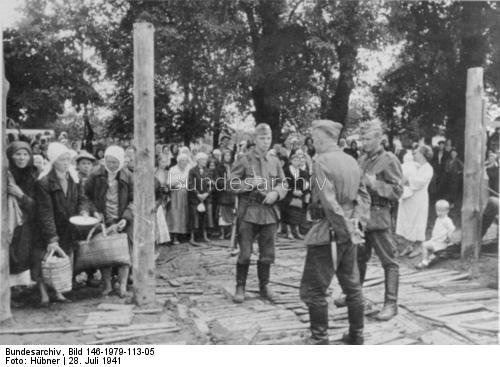 |
| "Women from the Winnica, Ukraine region come to a detention center to learn the fates of their husbands," 28 July 1941 (Hubner, Federal Archive, Bild 146-1979-113-05). |
Dutch submarine O-21 torpedoes and sinks 747-ton Italian freighter Monteponi ten miles north of Cape Comino, Sardinia. This becomes a favored scuba-diving site
Royal Navy submarine HMS Upholder spots an Axis convoy heading from Tripoli to Naples off Cape St. Vito. It torpedoes and sinks Italian light cruiser Garibaldi. The cruiser makes it to Palermo, Sicily at daybreak on the 29th and is under repair until November 1941.
The Luftwaffe bombs and sinks Royal Navy lighter A-8 off Bardia. There are 8 deaths. Another lighter, A-14, is nearby but escapes.
The Regia Aeronautica bombs and damages Royal Navy submarine HMS Olympus off Cavoli Light in the Tyrrhenian Sea. The submarine manages to make it back to Gibraltar.
The RAF launches raids from Malta on Sicily that destroy 36 Axis aircraft. The commanding officer of the Regia Aeronautica, General Federigi, perishes in aerial combat over Malta.
The Luftwaffe attacks the Suez Canal during the night.
The nightly run to Tobruk is made by destroyers HMS Hotspur and HMAS Vendetta. Early on the 29th, the ships take off some Australian troops - many of whom are exhausted from spending months isolated in the port with inadequate supplies and Axis shelling - and take them to Mersa Matruh.
Operation Guillotine, the Royal Navy reinforcement of Cyprus, continues as corvette HMS Hyacinth escorts transport Kevinbank to Famagusta.
An RAF night fighter unit begins operation at Malta. It is led by Group Captain George Powell-Shedden and based at Ta Qali.
 |
| Soviet POWs at Winnica, Ukraine, 28 July 1941 (Hubner, Federal Archives, Bild 146-1979-113-04). |
 |
| A Finnish soldier fires a Lahti L-39 20mm anti-tank rifle, 28 July 1941. The L-39 weighed 50kg and was one of Finland's main anti-tank weapons. Over 1900 were built in Finland during the war. |
Dutch/Japanese Relations: The authorities in the Dutch East Indies ban all oil exports, an obvious slap at the Japanese. This piles on to US sanctions recently imposed.
US/Japanese Relations: The Japanese retaliate for the freezing of Japanese assets in the United States by doing the same to US assets in Japan. This is more of a symbolic move than anything else, as there aren't many US assets in Japan.
Imperial Japanese Navy oiler Otowasan arrives at San Pedro, California to take on a load of oil. However, due to the embargo placed on oil exports to Japan begun on the 26th, it is refused service and must return to Japan only with ballast.
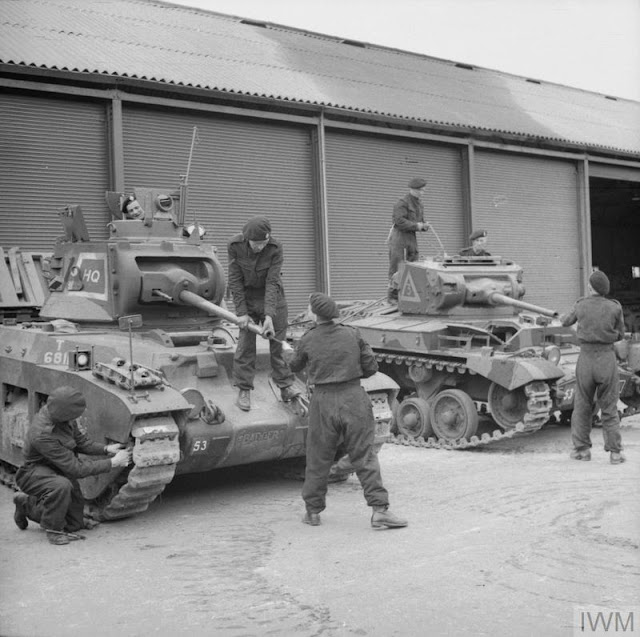 |
| "A Matilda tank and a Valentine of 40th Royal Tank Regiment, 23rd Armoured Brigade, 8th Armoured Division being 'bulled up' at Crowborough in Sussex for a 'Speed the Tanks' parade in London, 28 July 1941." © IWM (H 12185). |
Anglo/Soviet Relations: Soviet Premier Joseph Stalin receives a message from British Prime Minister Winston Churchill. This continues a pattern in their correspondence in which Churchill sends a stream of messages and Stalin rarely responds (he is said to be "too busy running the war," but this does not seem to hinder Churchill). Churchill comments that President Roosevelt's crony, Harry Hopkins, has left to visit the Soviet Union (by air, though that is not mentioned) and "You will be advised of his arrival through the proper channels." Hopkins is heading for Archangel. As usual, Stalin does not respond.
 |
| A Soviet T-28 medium tank lies abandoned in Ukraine, July 1941. |
US Military: The 1st Joint Training Force is formed, with commander Major General Holland M. Smith. This is just a redesignation of the joint US Army and US Marine Corps unit Task Force 18, attached to the US Atlantic Fleet.
German Government: Hitler recently has been clarifying in his own mind the ultimate objectives for Operation Barbarossa (incredibly, he seems not to have done this in any sort of detail before the invasion). According to the diary of his army adjutant, Major Gerhard Engel, today he somewhat randomly comments after the noon situation conference that he considers the southern lands of the USSR more important than Moscow or Leningrad. Engel writes that the Fuhrer reasoned:
Whereas Moscow was a big industrial center, the south was more important, where oil, wheat, more or less everything was located necessary to keep the country going. A land where milk and honey flowed.Engel concludes his entry by noting that Hitler commented:
One thing at least was absolutely required, and that was a proper concentration of forces. To use Panzers in fighting to demolish cities, that was a sin against the spirit. They had to operate in the open areas of the south. He had already started to hear the cries of those from whom they had been stripped; but that was neither here nor there.Hitler's generals, however, do not all agree with his economic reasoning. At least some think that taking Moscow would deliver a devastating psychological blow to the Soviet state, regardless of any economic considerations. In fact, some don't just think that but are covertly acting upon their own - and not Hitler's - priorities. Of course, they also would achieve renown by being the conquerors of Moscow.
French Indochina: The Japanese 25th Army begins landing its first of 30-40,000 troops at Saigon, Cam Ranh Bay and other strategic points in southern French Indochina. There are to be naval and air bases designed to project Japanese to the south - where the Japanese military covets sources of oil. The Japanese now have airfields within 300 miles of northern Malaya and naval bases within 750 miles of the British port of Singapore. Some Japanese army troops also arrive in Cambodia, the first of 8000 troops the Japanese will place there.
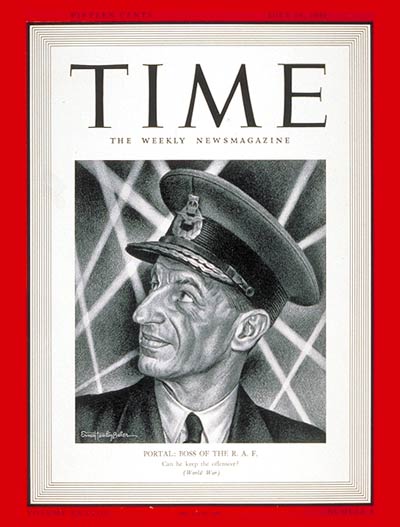 |
| TIME Magazine, Sir Charles Portal, July 28, 1941. |
China: The Japanese Imperial Air Force attacks Sichuan Province with 108 aircraft. The Chinese put up only seven fighters in opposition, and lose three planes. Chinese Lieutenant Gao Chunchou (I-153 no. P-7237) is shot down.
Holocaust: A "Euthanasia Program" begins at Auschwitz Concentration Camp when a select team of SS men arrives on Heinrich Himmler's orders. The first group of 573 sick Polish prisoners is taken from Block 15, along with two German criminals, to Sonnenstein Castle. There, under the supervision of Franz Hössler, the 575 men are exterminated in a shower room converted into a gas chamber. This apparently is the first use of such shower rooms, which quickly become stained blue due to the residue from the gas used.
At Drogobych, Ukraine, locals riot and kill an unknown number of Jews with their bare hands and whatever weapons are handy. Bodies of the dead and dying are thrown in the street.
 |
| Captured Soviet T-28 tank with Finnish crew, July 1941. |
Future History: Peter Claver Cullen is born in Montreal, Canada. He becomes a noted voice actor, perhaps best known for his role of Optimus Prime in the original 1980s "Transformers" animated series, Eeyore in the "Winnie the Pooh" canon, and the voice of the title character in King Kong (1976). As of this writing in 2018, Peter Cullen remains active, particularly voicing Optimus Prime in new projects.
 |
| Life Magazine, "Circus Family," 28 July 1941. |
July 1941
July 1, 1941: US TV Broadcasting Starts
July 2, 1941: MAUD Report
July 3, 1941: Stalin Speaks
July 4, 1941: Pogroms in Eastern Europe
July 5, 1941: Germans on Schedule
July 6, 1941: Australians Attack Damour
July 7, 1941: US Marines in Iceland
July 8, 1941: Flying Fortresses In Action
July 9, 1941: British Take Damour
July 10, 1941: Sword and Scabbard Order
July 11, 1941: Cease-fire in Syria and Lebanon
July 12, 1941: Anglo/Russian Assistance Pact
July 13, 1941: Uprising in Montenegro
July 14, 1941: Katyusha Rocket Launchers in Action
July 15, 1941: Smolensk Falls
July 16, 1941: Stalin's Son Captured
July 17, 1941: Heydrich Orders Mass Executions
July 18, 1941: Twin Pimples Raid
July 19, 1941: V for Victory
July 20, 1941: The Man Who Wouldn't Shoot
July 21, 1941: Moscow in Flames
July 22, 1941: Soviet Generals Executed
July 23, 1941: Secret Plan JB 355
July 24, 1941: Operation Sunrise
July 25, 1941: US Naval Alert
July 26, 1941: Italian E-Boat Attack on Malta
July 27, 1941: MacArthur Returns
July 28, 1941: Auschwitz Exterminations
July 29, 1941: Rescue From Crete
July 30, 1941: Raid on Petsamo and Kirkenes
July 31, 1941: Final Solution Order
2020
